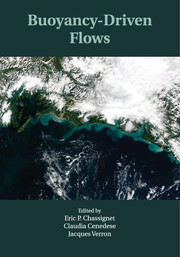Book contents
- Frontmatter
- Contents
- List of Contributors
- Introduction
- 1 Gravity currents – theory and laboratory experiments
- 2 Theory of oceanic buoyancy-driven flows
- 3 Buoyancy-forced circulation and downwelling in marginal seas
- 4 Buoyant coastal currents
- 5 Overflows and convectively driven flows
- 6 An ocean climate modeling perspective on buoyancy-driven flows
- 7 Buoyancy-driven currents in eddying ocean models
- 8 Atmospheric buoyancy-driven flows
- 9 Volcanic flows
- 10 Gravity flow on steep slope
- Index
- Plate section
- References
8 - Atmospheric buoyancy-driven flows
Published online by Cambridge University Press: 05 April 2012
- Frontmatter
- Contents
- List of Contributors
- Introduction
- 1 Gravity currents – theory and laboratory experiments
- 2 Theory of oceanic buoyancy-driven flows
- 3 Buoyancy-forced circulation and downwelling in marginal seas
- 4 Buoyant coastal currents
- 5 Overflows and convectively driven flows
- 6 An ocean climate modeling perspective on buoyancy-driven flows
- 7 Buoyancy-driven currents in eddying ocean models
- 8 Atmospheric buoyancy-driven flows
- 9 Volcanic flows
- 10 Gravity flow on steep slope
- Index
- Plate section
- References
Summary
Introduction
The Atmosphere
The atmosphere, like the ocean, is a stratified fluid highly influenced by the rotation of the Earth.
But, unlike the ocean, the atmosphere is a mixture of gases known as air.
The composition of the gas layer around the Earth has evolved very slowly since the time of its formation. Thanks to the appearance of life about 3.5 billion years ago, the main constituents of the air are now nitrogen (N2, about 78%) and oxygen (O2, about 21%). Other minor constituents are argon (1%), ozone, carbon dioxide, and water vapor.
The air near the surface is about 1,000 times lighter than the water in the ocean. It is also much more compressible. The mean state of the atmosphere is stably stratified and is in hydrostatic equilibrium (Figure 8.1). The first 10–15 km of the atmosphere, known as the troposphere, contain nearly 90% of the atmospheric mass. This is the layer where the weather occurs. The bottom of the troposphere, the boundary layer (BL), is directly influenced by the surface (land or ocean). Its mean depth is about 1 km, but depth can reduce to a few tens of meters on a cold winter day and expand to several kilometers on a warm, turbulent, summer day. The layer above the troposphere, called the stratosphere, is stably stratified. The stratosphere is the layer where the ozone chemistry protects the air and the surface below from incoming ultraviolet.
- Type
- Chapter
- Information
- Buoyancy-Driven Flows , pp. 312 - 337Publisher: Cambridge University PressPrint publication year: 2012

